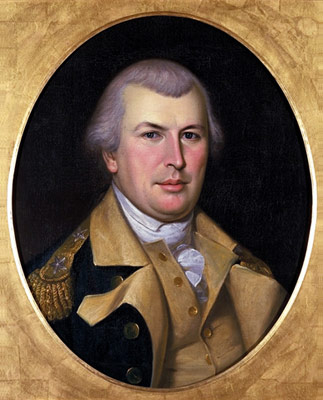In December 1780, General Nathanael Greene arrived in North Carolina, assuming command of the Southern Department of the Continental Army. It was hardly a coveted position. His predecessors had suffered catastrophic defeats—Robert Howe lost Savannah, Benjamin Lincoln surrendered Charleston, and Horatio Gates nearly handed the entire South to the British. Would Greene be the next to fall?

Greene, a self-educated strategist from the North, had never set foot in the South before his appointment. On paper, he seemed an odd choice, but George Washington had unwavering faith in him. Though Greene had once made a grave miscalculation at the Battle of Fort Washington, leading to a disastrous loss, Washington stood by him. Over four years of war, Greene had fought in nearly every major battle, matured as a leader, and sharpened his political acumen. He was Washington’s go-to man when dealing with Congress—firm but diplomatic, ensuring the army’s needs were met without alienating the politicians.
Upon arriving in Charlotte, North Carolina, Greene found his command in shambles. His “army” consisted of barely 1,000 men, mostly untrained militia, and supplies were nonexistent. His first move was to secure support from Southern state governments. Unlike his predecessors, Greene knew how to navigate political terrain as deftly as the battlefield. He patiently courted North Carolina, South Carolina, and Virginia, persuading them to contribute men and resources. But time was not on his side—British General Charles Cornwallis was already marching to crush him.
A New Kind of War
Greene quickly realized that conventional warfare was a death trap for his outnumbered, ill-equipped forces. Inspired by the recent Patriot success at Kings Mountain, where local militias had used hit-and-run tactics to defeat Loyalist forces, Greene devised a new strategy: guerrilla warfare. He would avoid direct confrontations, stretch Cornwallis’s supply lines thin, and strike when the British were vulnerable.
To execute this plan, Greene needed a capable field commander. Enter Daniel Morgan—one of the unsung geniuses of the Continental Army. A veteran of the Saratoga campaign, Morgan had retired to his Virginia estate in 1779, officially due to back problems but unofficially due to resentment over being passed over for promotion. But after Gates’ humiliating defeat at Camden, Morgan’s fighting spirit reignited. When Greene called, Morgan answered.
With Morgan at his side, Greene set the stage for one of the most dramatic military pursuits in American history. Cornwallis chased Greene’s army through the swamps and forests of the Carolinas in a desperate bid to force a decisive battle. But Greene and Morgan were always a step ahead, leading the British on a grueling chase while Patriot militias harassed their supply lines. Cornwallis’s army was slowly starving, exhausted, and demoralized.
The Battle of Cowpens: A Masterclass in Strategy
Greene eventually split his forces, sending Morgan west while he moved north. Seeing this as a fatal error, Cornwallis dispatched his fiery young cavalry commander, Banastre Tarleton, to crush Morgan before he could reunite with the main British force.
Tarleton, known for his ruthless efficiency (and the inspiration for the villain in the movie The Patriot), caught up with Morgan at Cowpens, South Carolina, on January 17, 1781. Rather than retreat, Morgan set an ingenious trap. He arranged his forces in three lines:
- Front Line: The least experienced militia, ordered to fire two volleys and then withdraw.
- Second Line: More seasoned militia, instructed to pick off British officers and then fall back.
- Final Line: Continental Army regulars and cavalry, hidden from sight.
Tarleton, overconfident and aggressive, fell for it. When the first two lines retreated as planned, he assumed they were breaking, just as Gates’ militia had done at Camden. He ordered a full advance—straight into Morgan’s final line of disciplined regulars. At that moment, Morgan’s cavalry, lying in wait, charged into Tarleton’s flank. The British were caught in a classic double envelopment, a maneuver that has been studied in military academies ever since. The result? A decisive Patriot victory. Tarleton barely escaped with his life, and his force was decimated.
Cowpens was a turning point. It shattered the myth of British invincibility in the South and forced Cornwallis to make desperate strategic decisions that ultimately led to his surrender at Yorktown.
Legacy and Modern Connections
Morgan’s brilliant tactics at Cowpens are still taught in military schools today, demonstrating the power of deception, terrain usage, and psychological warfare. His ability to understand his troops’ strengths and weaknesses allowed him to craft a strategy that played to their advantages rather than exposing their flaws.
Moreover, Greene’s leadership in the Southern Campaign showcased the effectiveness of asymmetric warfare—a lesson that has echoed through history, from the Vietnam War to modern insurgencies. His ability to combine military strategy with political negotiation ensured that the Patriot cause in the South did not collapse.
The legacy of these battles is not just historical but cultural. The film The Patriot (2000), starring Mel Gibson, drew heavy inspiration from Morgan’s exploits, introducing his story to a new generation (though with plenty of Hollywood exaggeration). Cowpens remains a symbol of American resilience and strategic ingenuity, proving that brains can triumph over brute force.
In the end, Greene and Morgan didn’t just outfight the British—they outthought them. And that, more than anything, secured their place in history.

No comments yet.